1 April 2019
One of the things I love in Latin America is the abundance of food and eating choices. When I first came to Rio de Janiero I couldn't feel disappointed. Even though the choices and menu vary from neighbourhood to neighbourhood it is still good and it's hard to be left hungry in town.
The best places to eat are transport hubs or neighbourhood central areas and you can hardly see a street without a bar, shop or a food stall. As a result you can find everywhere bars opened even on Sundays and national holidays. And it's where locals like to gather in the evenings and free days too to eat and spend time with family and friends.
What I always look for and what’s the best to me is the street food - it’s the cheapest one and easily available. The same is in Brazil.
You need to bear in mind that usually on Sundays and Bank Holidays/ national days you will not see street food except near events or touristy places like on the beach, near underground stations etc. In some leisure areas like Lapa you can see local bars open even on the Easter Sunday.
The most popular street food is:
10. Caldo de cana
9. Milho / Pastries / Churros
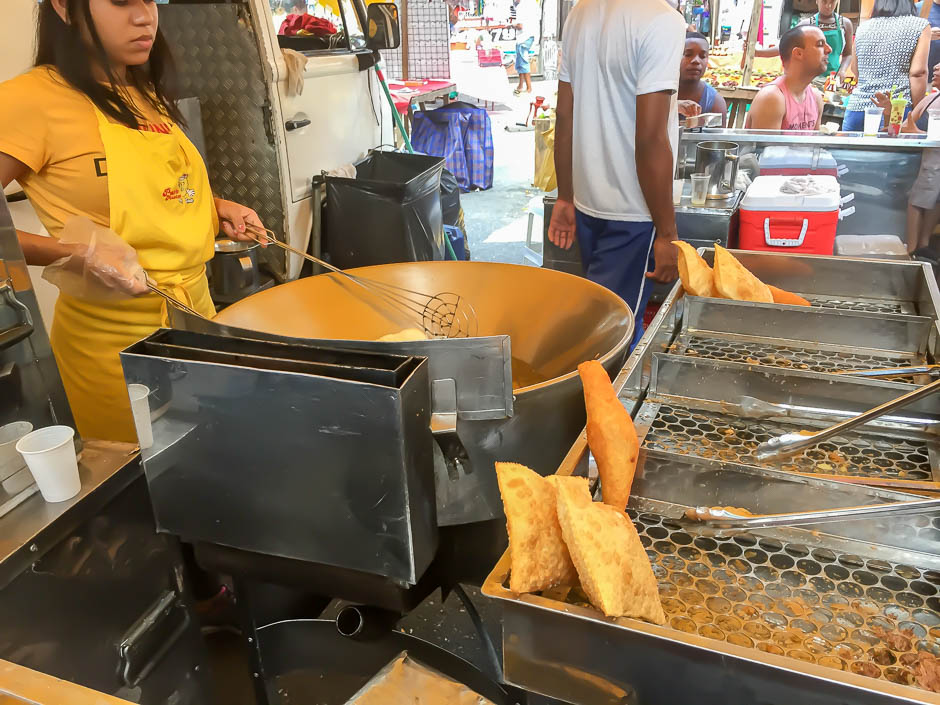
Are you hungry or just want to snack something on the way? No problem - grab a buttered and salted corn cob or a fat churro. You can often find them in stalls at busy city squares and along the beach front.
While corn cobs are the same as they are everywhere in the world, churros are snacks quite specific to South America. I saw them in many countries and was surperised to find them also in Rio. They're plump pastries fried in a shape of long tube which then is filled with chocolate or caramel and topped with sugar. Fat and sweet indeed.
Other types of pastries you can often spot at fruit markets, shops or events - deep fried envelopes holding meat, chicken or cheese filling. Sometimes they come in a shape of half-moon like Spanish empanadas and are also fried with similar fillings. They're always savoury - I've never met them with vegetables though or with fruits.
Pastries, churros or corn cob usually costs just R$5.
8. Yakisoba & Comida Arabe
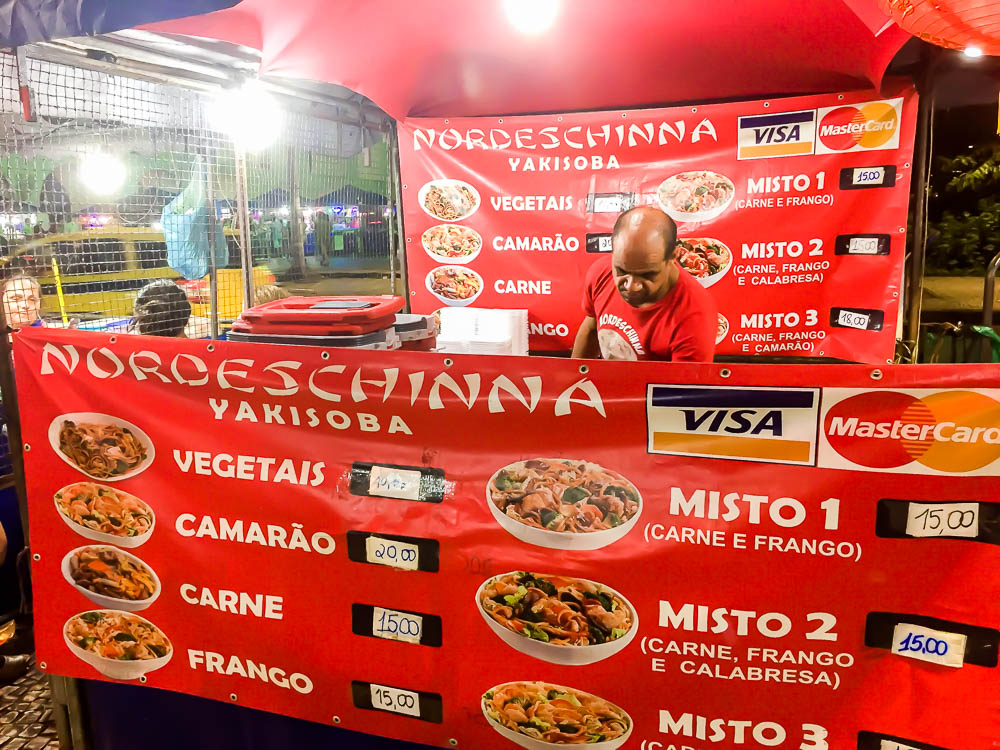 Let's be honest, Brazil is not the heaven of international cuisine connaiseurs but even here exotic influences made they way through and became part of popular menu. The usual sighting is comida arabe or so called comida da Siria which consists of baked or fried snacks usually with meat and cheese filling.
Let's be honest, Brazil is not the heaven of international cuisine connaiseurs but even here exotic influences made they way through and became part of popular menu. The usual sighting is comida arabe or so called comida da Siria which consists of baked or fried snacks usually with meat and cheese filling.
A hit of exotic cooking is Japanese food, often it's just a choice of egg noodles with various meat choises and vegetables in soy souce. It's commonly called here as Yakisoba cooking. It's available as street food - in small stalls - and also there are various restaurants serving egg noodles and even sushi. Street noodles are nothing sophisticated though so be prepared for very basic and cheap version of Asian cuisine.
7. Street Drink Bars
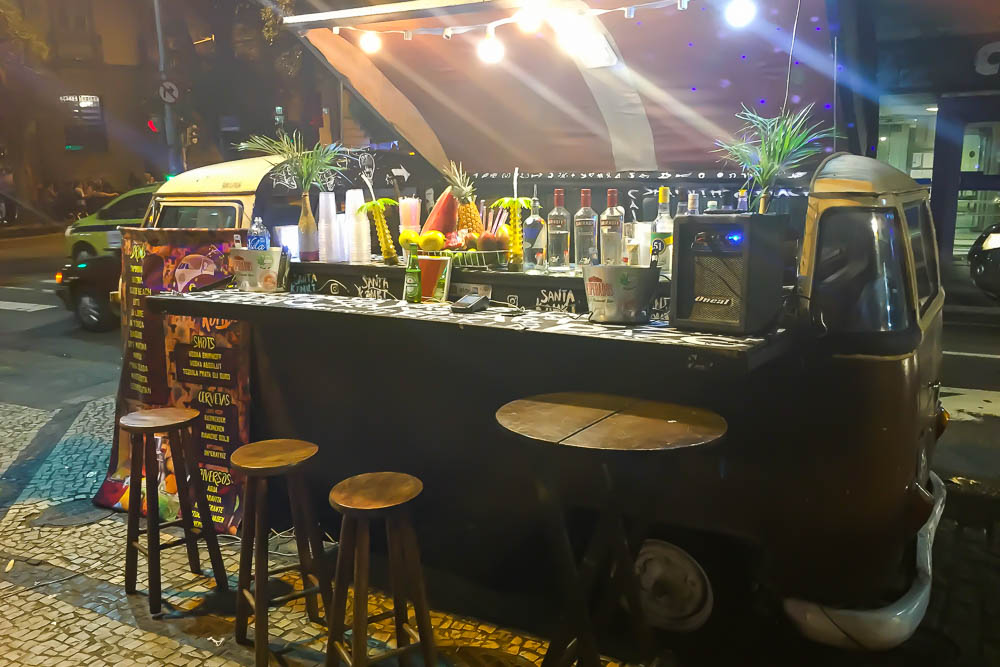 Like in every country Brazilians like to go out after work or at weekends. There are lots of clubs and places to go but what's cool about Brazil is that here you get endless opportunities to party on the street. So bars and eateries pop up around as well. Some are ordinary stalls, some a bit more fancy and creative like the one pictured above - a bar made inside an old minivan.
Like in every country Brazilians like to go out after work or at weekends. There are lots of clubs and places to go but what's cool about Brazil is that here you get endless opportunities to party on the street. So bars and eateries pop up around as well. Some are ordinary stalls, some a bit more fancy and creative like the one pictured above - a bar made inside an old minivan.
The drink choices are colourful and most offer top three:
- Caipirinha. National Brazilian alcoholic drink made with cachaça rum, lime juice and sugar. There are varieties where you can ask for any other fruit than lime, eg. watermelon, pineapple, mango, kiwi etc. Mind this is a strong drink!
- Caipivodka. The same like caipirinha, the only difference is that cachaça is replaced with vodka, although you may ask for any other alcohol.
- Caipifruta. This is similar to the above with lots of mixed fruit and optional condensed milk to make it less strong and sweet in taste.
The bar offers doesn't end here of course but that's the most popular drink menu.
You have also plenty of non-alcoholic drinks on offer and I recommend to try fizzy drinks made in Brazil that keep the world class quality. The number one of them is guarana, which is a drink based on Amazon's plant and named after Guarani tribe who used to drink a brew. Another good try is guaravita.
6. Vitaminas or Natural Juices
This is what make me love tropical/ hot countries - the abundance of fruits and the fact that you can drink fresh squeezed juices not a concentrated sweetened "sorry-liquids" which are a norm in northern countries.
Brazil doesn't dissapoint. Juice bars in Rio de Janeiro pop up in every neighbourhood and often several on one street. They offer one-fruit fresh juices for as little as R$6-R$9 and you can choose from endless number of fruits: orange, mango, pineapple, watermelon, papaypa, passion fruit, grapes, lemon, guava, strawberries, bananas, apples, ...; also such exotics like graviola, carambola, quaqui, caju...
If you have not enough you can ask for a "vitamina" which is a mixed drink of various fruit juices. Which fruits? The choice is yours.
5. Churrasco
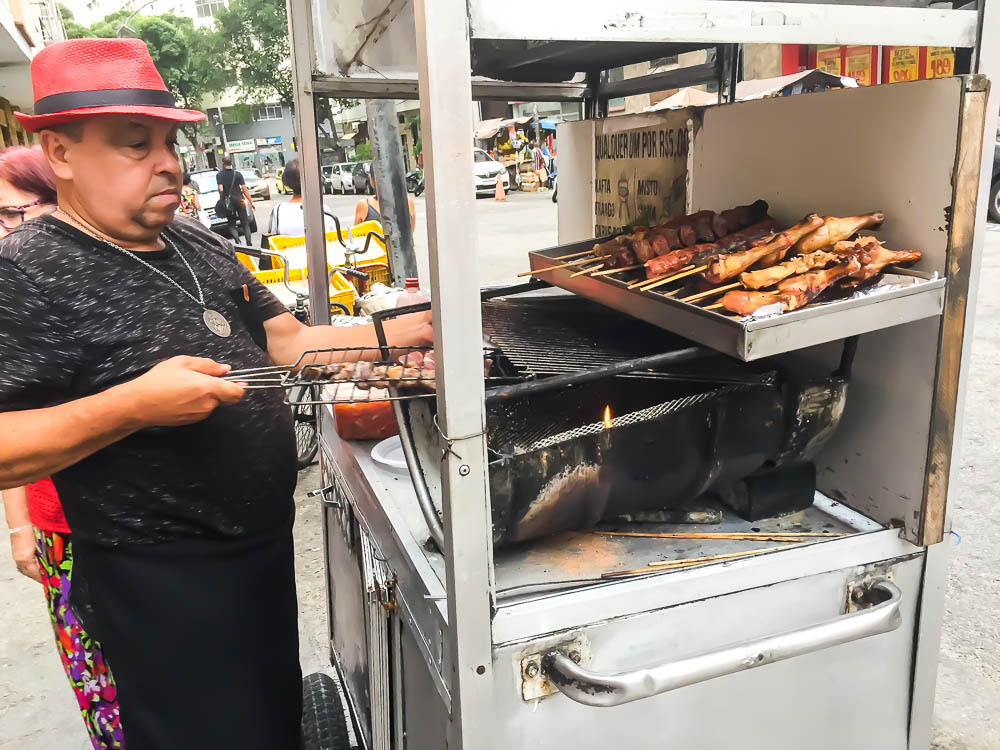
4. Pipoca
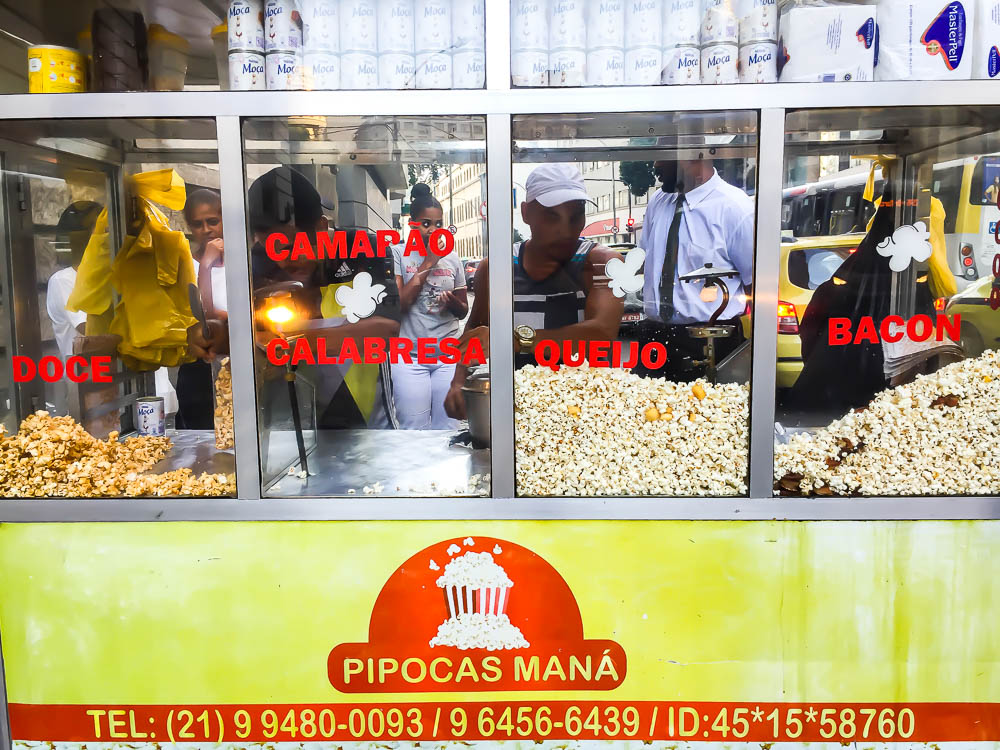 This cute name simply means "popcorn". You could think - great but what's so special about it? You can find it anywhere in the world. True but in Brazil they don't just do sweet or salted popcorn. If you come here you must try: popcorn with chease (halloumi style), with bacon, with caramel or even sausage.
This cute name simply means "popcorn". You could think - great but what's so special about it? You can find it anywhere in the world. True but in Brazil they don't just do sweet or salted popcorn. If you come here you must try: popcorn with chease (halloumi style), with bacon, with caramel or even sausage.
Pipoca usually costs R$3-R$10 depending on serving size.
3. Açaí
It's difficult to walk through main sqaures or popular spaces in Rio or at the seafront and not to find an açaí seller. It's one of the most popular desserts and very much liked by locals and tourist alike.
Açaí is fruit of a palm growing in Amazon, sometimes called oak berry in English. The dessert consists of a frozen pulp sold in plastic cups with toppings such as crushed peanuts, milk powder, chocolate bits or granola and a custard of the taste of your choice. It's usually mixed with bananas, sometimes other fruits like strawberries. And of course sugar to make it sweet. Basically it's a sort of sorbet made of açaí fruit.
Some stalls praise health benefits of consuming açaí but its qualities have not been proven. It's quite tasty though and is one of my favourites too. I have never seen the berries themselves in Rio, however you it's possible to buy açaí in powser from casas Pedro or other natural food stores.
The cost of açaí is anything from R$3 for 250ml cup to R$15 for 1L.
2. Tapioca
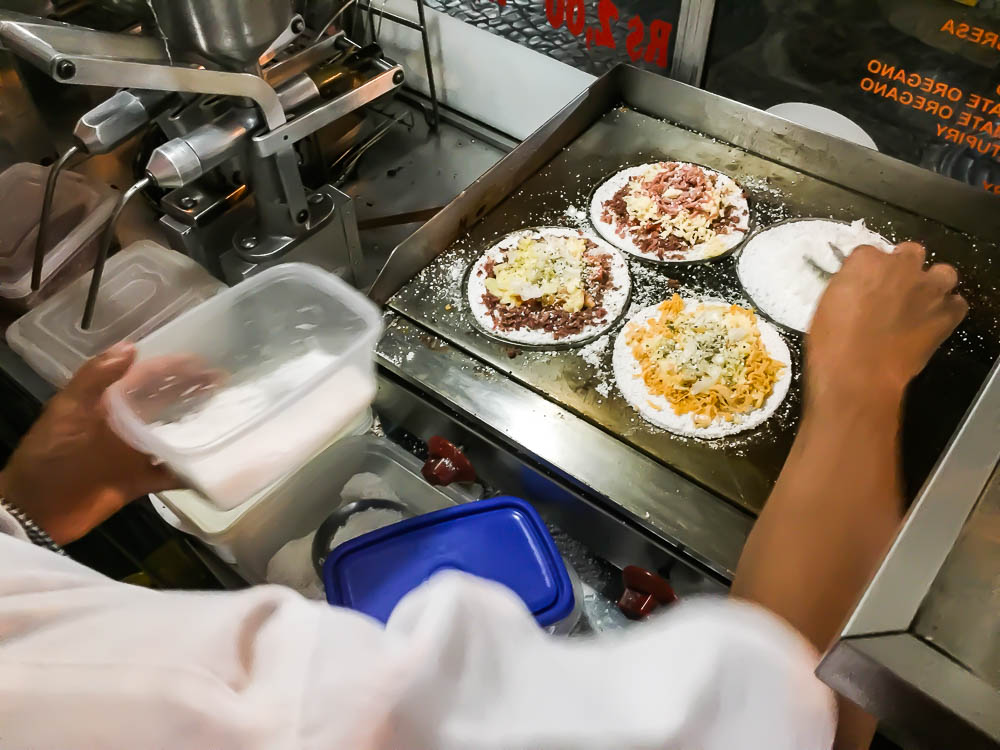 It doesn’t really have a taste but that’s the beauty of it because it goes well with pretty much everything.
It doesn’t really have a taste but that’s the beauty of it because it goes well with pretty much everything.
Tapioca is sort of a thin pancake made of manioc flour - so ideal for coeliac people. It is served with savoury or sweet filling - the most popular are ham, cheese, chicken meat, beef, you can ask to top it with tomatoes, onion, oregano. If you wanna make it your desert you can ask for: banana, chocolate, coconut, nutella, doce de leite (caramel), goiabada (guava paste) etc. My reent discovery is tapioca with cheese, goiabada and coconut... yummy.
If you want to become Brazilian food master and make tapioca at home it’s very easy too. I usually prepare it when I’m hungry and I don’t have much time for cooking. I also developed my own fillings: gorgonzola with walnuts, Mexican style with avocado, tomatoes and cheese (you can add black beans), blue cheese with watercress and dried tomatoes etc.
Tapioca is also cheap and quick street food, from $R5 to R$12 depending on the filling and place.
1. Pao de queijo or Cheese Balls
...if you wanna say it nicely in English, are small baked balls made of tapioca flour and cheese. Very popular snack indeed and it's on top of favourites of many visitors to Brazil.
The best are in Rei do Mate and Casa do Pao de Queijo chains but they are available to buy in many cafes, bars and bakeries. You can also buy them frozen and bake at home. The price ranges from R$2.50 for 5 balls to R$12 for 9 balls, depends where you buy it - simple stall or café.
It's a yummy snack you cannot miss while on your holiday in Rio.